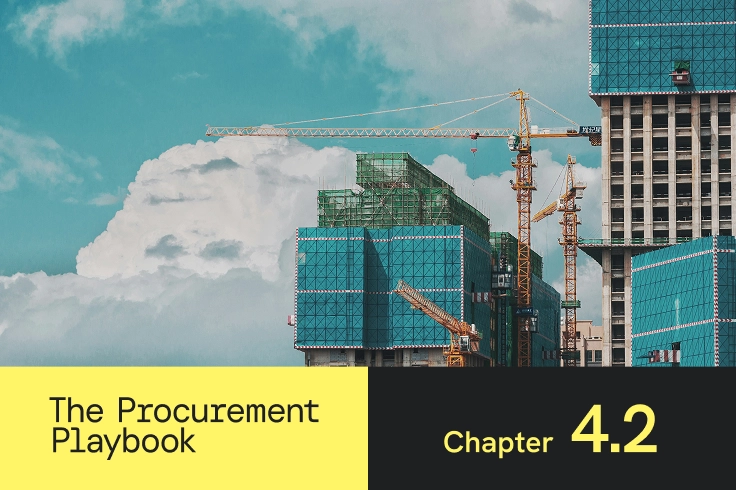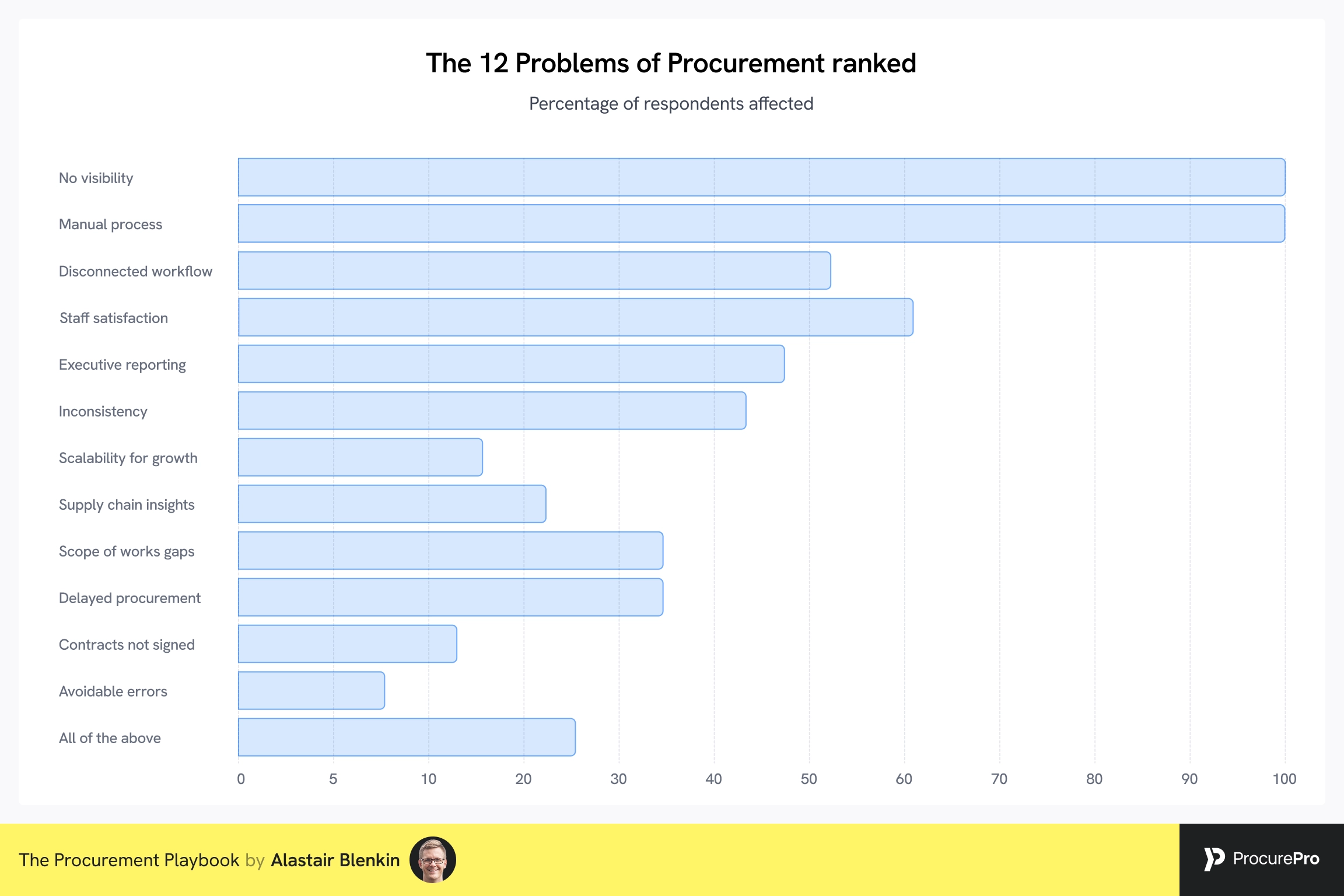Chapter 4.1
The 12 Problems of Procurement: symptoms & root causes
Below we break down each of the 12 Problems of Procurement by:
The symptoms (how you might speak about them)
The root cause (why they exist)
The solution (watch the webinar for more context)
Unpacking the pain sets the foundations for the following chapter on connecting procurement end-to-end.
Also, check out the table below to see which of the 12 problems is felt most by your industry peers.
"Live tracking of procurement used to be almost impossible – it would probably have taken a team of junior QSs to collate everything into one place. Now all the information is in a single system and the process gives us a full audit trail on all of our procurement."
Problem 1
No visibility
To find out procurement status, you’re physically picking up the phone, sending an email, or tapping someone on the shoulder.
Most commercial teams only look at the status of each package in a weekly 1-hour meeting or when someone asks “where is this package up to?” or “have you got quotes back yet?”
Symptoms:
Root cause:
The Solution:
“The Old Way of doing it with Excel documents, Word documents, was a manual process and really time consuming for everyone.”
Problem 2
Manual process
Emails, phone calls, and spreadsheets still dominate procurement workflows but the majority of these processes can be automated.
Manual admin often takes 30 - 40 hrs per package, with 20 - 40 trades per project, and 10 - 20 projects a year.
Depending on the size of your commercial operations, that’s anywhere from 6,000 - 32,000 hours of manual work in a year.
Symptoms:
Root cause:
The Solution:
“We don't procure any differently to any other contractor in the business. So, why on earth do we create all this process that's slightly different but brings no value? The fact that procurement is so fragmented, bringing it into a system brings visibility.”
Problem 3
Disconnected workflow
Procurement is a simple word for a complex process. From tendering to delivery, placing a package takes hundreds of actions across 20+ systems and processes.
This disconnect in your workflow leads to wasted time as teams struggle with switching tools and losing track of their work.
Symptoms:
Root cause:
The Solution:
“Order approvals were traditionally done via email...those trying to gain approval would struggle to know where it was in the system. Now, approvals are much more efficient in terms of getting signed contracts back from the supply chain.”
Problem 4
Delayed procurement
Engaging your supply chain at the early stages of a project is a big undertaking. You’re trying to procure quickly to deliver on time, whilst diligently ensuring you’re maximising value and margins whilst in a competitive state.
High-risk, high-value packages are on the critical path. Procurement delays are frequent, ultimately having a domino effect on the delivery programme.
Symptoms:
Root cause:
The Solution:
“We had an Excel tender-event schedule that was put up on the screen. No one could read it. No one could understand it. ProcurePro allows us to see exactly where every single package is in the process and how we're doing against budget."
Problem 5
Limited executive reporting & insights across projects
Producing reports that collates information across different projects, trades, subcontractors, and staff is tricky business.
It needs to be driven by the Executive or a Commercial Director, and manually collated by busy Project Managers, Quantity Surveyors or trainees. More often than not, it just doesn’t happen.
Symptoms:
Root cause:
The Solution:
“There was inconsistency in our procurement documentation. We generally didn't have it, but ProcurePro allowed us to really bring consistency to our entire procurement process.”
Problem 6
Inconsistency across projects & people
As businesses grow, it's critical to standardise ways of working to ensure quality and scale without stumbling.
The challenge is that construction projects are effectively mini-businesses. People moving around the industry bring different habits and behaviours, both good and bad.
Symptoms:
Root cause:
The Solution:
“We've had a bit of growth over the last couple of years, with new people coming through the business. ProcurePro just makes it so much simpler to get them up to speed by being really clear and easy to follow.”
Problem 7
Scalability for growth
As projects and teams multiply, procurement challenges compound.
While growth is often a key business objective, scaling teams with non-standardised processes and inadequate controls results in inefficiencies, increased errors, and decreasing customer satisfaction.
Moving people between projects means losing valuable project knowledge, spending weeks getting them up to speed.
Symptoms:
Root cause:
The Solution:
“Reports give us massive insight across the business. We use it for procurement opportunities. We have direct visibility now to see whether a couple of project teams are all procuring for a painter at the same time."
Problem 8
Supply chain insights
Typically, contractors engage with thousands of subcontractors, suppliers, and consultants. At this scale, completing due diligence for financial, compliance, workload, skills, and performance assessments is a significant undertaking.
There is risk out there, but where is it, and how much will it cost you?
Symptoms:
Root cause:
The Solution:
“I had a particular issue with scope of works gaps. As a contractor, that's where we lose money or make it. That is our biggest issue in the industry. It's not defining the scope of works properly and fairly so that people know what they're meant to be doing.”
Problem 9
Scope of works gap
A scope of works typically covers 85 - 95% of procured costs, with the remaining 5 - 15% being variations and unforeseen costs.
Scope quality issues create non-recoverable variations, which eat directly into margins and contingency.
Getting scopes right is one of the most time-consuming parts of procurement, so it’s no wonder that scope gaps appear.
Symptoms:
Root cause:
The Solution:
“The cost of non compliance - contracts not signed, wrong attachments, contracts amended without knowledge/permission, lost contracts, wrong details entered into contracts. Everyone has had these issues and they can be huge if you ever have a dispute with a subcontractor!”
Problem 10
Contracts not signed
Delays in signing contracts or starting work without agreements expose projects to major risks.
Subbies coming on site without a signed contract will often be accepted by a site team focused on delivering the project, without considering the legal implications.
While it doesn’t happen often, everyone in the industry has a war story where a missing contract has caused serious headaches.
Symptoms:
Root cause:
The Solution:
"We might have a facades contractor that's on ten jobs and we think, ‘why did we do that?’ . We later realised that nobody was actually talking to each other about it.”
Problem 11
Avoidable errors eat into margins
Everyone in construction knows that many human errors occur across the duration of a project and, whilst perfection is never achievable, many errors are avoidable.
For procurement specifically, 0.5 - 1% of project value represents procurement risks and contingency. This is $500k - $1M of risk, for every $100M turnover.
Symptoms:
Root cause:
The Solution:
“Procurement, it's the core of what drives our construction business. Whether it's visibility, whether it's the access to the data, whether it's working smarter, even down to retention of our workforce. It's all linked to making things easier for the team.”
Problem 12
Low staff satisfaction and poor training
Construction needs people, relationships, and cooperation.
RICS bespoke charity, Lionheart, cites that stress is the biggest health concern for surveyors. Pressure to meet deadlines is exacerbated by tight margins, mounting workloads, and fragile supply chains. Why pile on frustrating, clunky tools?
Symptoms:
Root cause:
The Solution:
In this chapter
The first step to better building

4.2 – You can’t solve supply chain without procurement
Practical guidance on solving these 12 problems in your business, including an exclusive webinar with industry voices.
Watch the on-demand webinar
Skip the reading and watch our webinar on The 12 Problems of Procurement, with industry guests Mark Tant and Thomas Reinhardt.













